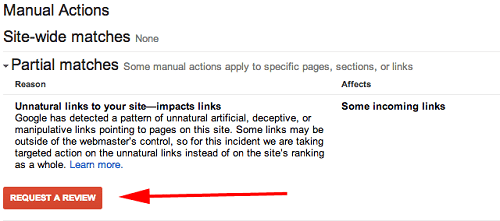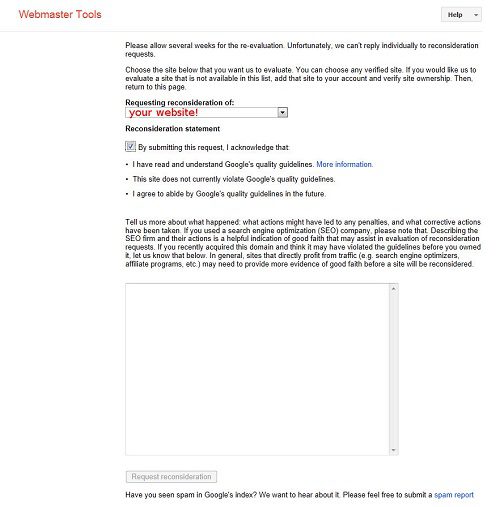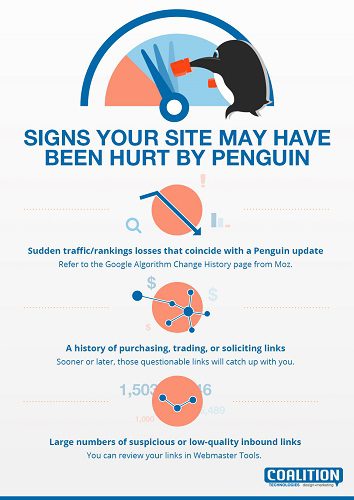Holy algorithms, Batman! Looks like the Penguin is up to his old tricks. Well…the Penguin is indeed looming, but it doesn’t wear a top hat or carry an umbrella. This Penguin is the kind that wreaks havoc on your Google rankings, and recent reports indicate that it’s due for a visit any day now. At Coalition Technologies, we have successfully helped companies large and small with Google Penguin recovery, but as the old idiom goes, an ounce of prevention is worth a pound of cure. Is your website prepared for the coming storm?
What Is Google Penguin?
Without getting too technical, Penguin is a Google algorithm update that detects the kinds of nefarious webspam techniques often used to manipulate search engine rankings. It was first introduced in April of 2012, and it has gone through a number of changes since that time. Essentially, Google Penguin prevents webmasters from using black-hat, artificial link-building techniques, thereby ensuring that the highest-ranking content remains focused and relevant. Unfortunately, well-meaning webmasters are sometimes penalized despite the purest of intentions. But whether you have made some mistakes or are just an innocent casualty, Google Penguin recovery is possible.
Why Penguin Exists (An SEO History Lesson)
In order to understand why Penguin is necessary, you need to understand the history of (outdated) search engine optimization (SEO) techniques. In the pre-Google days, webmasters were able to use increased keyword density to easily boost their rankings. For example, if you wanted your pizza restaurant in New York City to be the first site that appears when people search for ‘NYC pizza,’ you would use that phrase multiple times throughout your site’s content. Of course, before long, everybody figured this out, and the Web was flooded with low-quality, keyword-stuffed content that provided no value to the end user.

When Google came along at the dawn of the 21st century, they completely changed the game with their proprietary PageRank algorithm, which was based heavily on academic notation. This basically meant that websites with many links pointing to them were more important and authoritative, and therefore would rank higher. Once again, ambitious webmasters and SEO specialists figured out ways to make the system work for them, and started buying links from authoritative sites. Before long, savvy developers began creating automated link-building software capable of solving CAPTCHAs, building profiles, creating email addresses, and more.
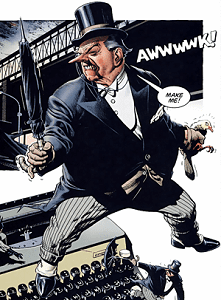
Eventually it became clear that PageRank was not sufficient to block webspam, and so Google began implementing a series of state-of-the-art algorithm updates designed to locate and combat those sites that would attempt to game the system. The first high-profile update was known as Panda, first implemented in 2011 to reduce the ranking of low-quality, “thin” sites, and boost high-quality “full” sites. Panda came largely in response to the enormous influx of “content mills,” websites that would flood the web with thousands — in some cases even millions — of pages of low-quality content meant to drive traffic via strategic keyword usage.
The early Panda updates had an absolutely devastating effect on countless websites that once ruled the Web, including eHow and About.com, but Google wasn’t done yet. With thin content becoming less prevalent in the SERPs, it was time to go after the ever-growing problem of linkspam, and that’s where Penguin comes into play. The first Penguin update was announced on April 12, 2012, and like the Panda that preceded it, it sent webmasters into a tailspin. Unnatural-looking links were deemed manipulative, and search rankings for countless websites began to plummet. Unfortunately, not all of those businesses were engaging in shady link practices.
The Innocent Bystander Effect
Alongside many of Google’s other updates, Penguin is designed to prevent people from using illegitimate link-building methods to boost SERP positions. As you might expect, clever SEO specialists and webmasters are always finding new workarounds, which is why Penguin is updated to keep up. The issue at hand is that – like any war – there are going to be innocent casualties. Plenty of websites that use completely legitimate white-hat SEO techniques are being penalized, and even worse, many of the webmasters who have been hit don’t even realize it. That is why understanding Google Penguin recovery is so crucial at this point in time.
Why Websites Are Targeted
In order to prevent your website from being penalized, it is important that you understand exactly what Penguin is hunting for. Basically it seeks out websites that have questionable link profiles, which can be attributed to links stemming from low-quality sites or sites that are irrelevant to your own. Keyword-heavy links, purchased links, and overly optimized links also raise red flags. A major part of Google Penguin recovery is going to be undoing these links that are dragging your website through the mud, which can be a timely and often difficult process.
Analyze Your Website Profile
While it may end up being a time-consuming process, you are going to need to thoroughly examine all links pointing to your website. This can be done by creating a spreadsheet using your Google Webmaster Tools interface. You may be able to use software to analyze the data, but doing it manually is usually a safer bet. If you have a significant amount of links, or if you are simply not familiar with SEO, this can be an arduous task. Coalition Technologies has the experience, skills, and resources to handle all of your Google Penguin recovery needs, so if you need assistance, please give us a call.
Are Your Links High-Quality?
There was a time when every link was a plus, but that is no longer the case. Today you must keep an eye on every link that points to your website. If you want to keep a clean link profile, heed the following:
- Use Google Webmaster Tools to keep an eye on your inbound links. It’s a good idea to review all new, incoming links at least once a month.
- Focus on relevance. Are your inbound links — for the most part — coming from sources within your niche or industry? Or is it clear that the link is forced?
- Visit each website that links to yours, and examine the overall quality. Is the content well-written, or is it riddled with grammar and spelling errors? Is the website professionally designed, or does it look like it was hastily made by an amateur? You may also want to examine the company’s social media presence to determine if it is A) a legitimate resource and B) still an active website.
- Note the common red flags, including links that appear in blog rolls, footers, or on websites that clearly offer no value to anyone.
Consider the Timing of Your Link Acquisitions
As you consider your risk, you also need to think about when your links were acquired. If you gained many links at once, you may be at risk because Penguin may assume that you purchased links in bulk. Of course, many simultaneous link acquisitions can also be the result of your content going viral, but more often they are purchased or gained through automated software. If you did purchase bulk links in the past when it was more acceptable, it may be time to cut your losses.
Has Your Website Already Been Affected?
You will not receive a notification for a penalty stemming from an algorithm update, because Google does not consider it a penalty, per se. Yes, you’re definitely facing the wrath of a search engine overlord in response to a perceived infraction, but as far as Google is concerned, it’s just an algorithmic rankings adjustment. Nothing personal. The most obvious symptoms of a Penguin penalty are major shifts in organic traffic numbers and SERP rankings. Examine your search-related traffic, and cross-reference it with the dates of each Penguin update. If you notice that drastic shifts in numbers coincide with any of those dates, you have most likely been affected, and you will need to take proactive Google Penguin recovery steps. On the other hand, if you notice an increase in those numbers, you may have actually benefited from a Penguin update (sometimes your competitors’ loss is your gain).
Clean Your Link Profile
So you’ve been penalized. Yes, this can be a daunting realization, but all is not lost. The first step is going to be to get rid of all of those dirty links. Start by simply sending an email to the webmaster of each website to request that the link be removed. Getting the link removed entirely is the best course of action, but if you don’t receive a response, or if the webmaster cannot remove the link or even flat out refuses, you do have other options.
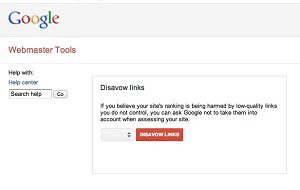
If you are unsuccessful in your attempts to have negative links removed, you will need to disavow them. To do this, go to your Webmaster Tools, and use the Disavow Tool to notify Google of your request. Once you have done that, you’ll just have to be patient and work on bolstering the value of your site as much as possible, in order to gradually build those rankings back up.
Manual Penalties
But there’s another kind of penalty that we have yet to discuss, and it makes the Penguin look like a lightweight. We’re referring to the dreaded Manual Spam Action. If you have already set up your website in Webmaster Tools, you may receive a notification that you have been hit by a manual penalty, which means that an actual human auditor inspected your website and flagged it as violating Google’s policies. When a manual penalty occurs as a result of linkspam, you will need to identify and remove negative links, and then also send a reconsideration request to Google.
Manual penalties are the worst, because unlike algorithmic rankings losses, they are treated as legitimate penalties by Google, and in some cases they can even result in your site being de-indexed. Before sending your reconsideration request to Google, make sure to go through your entire link profile with a fine-tooth comb and eliminate or disavow every questionable URL, without exception.
How to Send an Effective Reconsideration Request
So you received notification of either a partial or site-wide manual action. First, check to make sure that the action is in fact a penalty, as removing a non-penalized link won’t affect your ranking either way. Once you have determined that the action taken is definitely a penalty, you will need to appeal to Google. First and foremost, keep in mind that the people at Google probably have the book of excuses memorized at this point, so your best bet is to be completely transparent.
Go to the “Manual Actions” option in your Webmaster Tools, and write an honest summary of what you did (knowingly or unknowingly) to cause the penalty, and then explain what you have done to rectify the situation (identifying and removing/disavowing bad links). This proves that you understand the rules, and are therefore less likely to be a risk in the future. If you don’t know what you did wrong, consult an SEO professional. Proving that you recognize the error of your ways is critical (you may have to swallow a lot of pride for this step).
Finally, explain the steps that you are going to take from now on to prevent your website from being part of a low-quality link chain. You must make it clear that you will not engage in questionable link-building practices in the future – whether you initially did so intentionally or by accident. The important thing is that Google believes that you are going to be a positive contributor moving forward.

When you submit your reconsideration request, you must portray your organization as a professional and reputable one. If you are not confident in your technical or professional prowess, it is usually a better idea to have a knowledgeable SEO company assist you. The staff here at Coalition Technologies has a tremendous amount of experience working with the webspam team at Google, and we will be more than happy to aid you in creating the perfect request. Remember, this is not something to be taken lightly, and a rejection can cause serious problems now and in the future. Don’t go through the process of a Manual Spam Action or Google Penguin recovery on your own.
When to Resubmit your Request
In most cases, you should hear a response back from Google within a few days to a week. If two to three weeks pass, you may want to submit your reconsideration request a second time. You may also want to resubmit your reconsideration request if you never received an email confirmation stating that the request was received. Do not resubmit your request otherwise, as the last thing you want to do when fighting a spam penalty is to spam!
Possible Responses
Within two weeks, you should receive a response from Google. There are four possible responses that will determine your next course of action:
1) Google accepts your reconsideration request and revokes the manual spam action
2) Your request is denied
3) Your request has been processed, but not all issues have been resolved
4) No manual actions were found
If your request is accepted or if no manual actions were found, you can simply proceed (with caution, of course). If your request is denied or is still processing, you will need to take additional action to make your website meet Google’s quality guidelines. Remember, the process can span multiple months – especially if you don’t do things right the first time – so contacting a professional is the clear course of action at this point.
Avoiding Future Penalties
Whether you have weathered the storm of a Manual Spam Action or suffered rankings losses due to a Penguin update, now is the time to start proving that you are a positive contributor, or at least that you will be moving forward. Hopefully this will be your second chance, an opportunity to walk the straight and narrow from here on out. In fact, you can even look at this whole process as a positive step that may eventually lead to a more successful website in the long run. The Google Penguin recovery process is a long one, and it means you are going to have to reconsider your current strategies. Here is some advice on transitioning seamlessly into the next phase of your site.
Earn Your Links Legitimately
Moving forward, quality is king. After all, the most effective way to get backlinks is to deserve them. Instead of focusing on link building, focus on creating the best possible content that you can, and the links will come naturally. There are white-hat SEO techniques that can be extremely helpful, but pursuing those can carry considerable risk if you are not 100% confident in your technical knowledge and abilities. After all, nobody wants to deal with Google Penguin recovery twice. In most cases, the best approach is to hire a reputable SEO service to get your website back on track.
Think about What Your Readers Want to See
A good rule of thumb to keep in mind moving forward is to try to gain inbound links that would benefit your organization even if search engines did not exist. Try to form relationships with websites that offer something to your readers. While you don’t want to give business away, you should be able to find publications that are part of the same community, allowing you to carve your own niche. Try to offer content that your readers can’t get anywhere else. This is the simplest and best way to generate repeat, long-term traffic.
Recovering Lost Google Rankings
Regaining your lost SERP ranking can be an uphill battle, especially if you try to go it alone. It is also worth noting that if your website was artificially inflated by low-quality inbound links, you may never regain your ranking without some drastic changes to your strategies. The easiest and most effective way to regain your momentum is to hire a qualified SEO company. Attempting to manipulate the system a second time is only going to result in more serious – and possibly even permanent – penalties.
At Coalition Technologies, our knowledgeable team has the technical expertise to boost your rankings without breaking the rules. We can help you from the moment you receive a penalty, throughout the entire Google Penguin recovery process, and then also as you move forward into the future. We have a consistently proven track record of success, and we are confident in our ability to help your company to recover and soar.
Timing Matters
As you can probably tell, the world of SEO is far from static. What works today may not work tomorrow, and it is important that you stay informed and up to date. The brute force SEO techniques of yesterday are long gone, but there are ways to stay ahead of the curve without putting your website at risk. If you are not the most tech-savvy webmaster out there, we encourage you to give us a call so we can help. Online marketing has never been so relevant and important, and our track record is evidence of our commitment to quality, lasting results.
Preparing for the Latest Update
Google is poised to launch an updated version of Penguin, so it is certainly possible that new Google Penguin recovery techniques will be necessary. As you might expect, Google is not exactly candid about what each update will bring, so it is best to take action now before the penalties are dealt out. One thing we can safely assume is that this update is going to present new challenges to today’s SEO specialists, and the team here at Coalition Technologies is ready to meet any approaching obstacles head on.
How Worried Should You Be?
It is worth noting that Google Penguin tends to be pretty accurate in its assessments of linkspam (even more now than in the past), and Google is not going out of its way to hunt down legitimate websites. However, if you have used potentially illegitimate SEO techniques in the past, or if you are just not sure, there is no harm in taking preemptive measures to protect your website. If there is any doubt in your mind, now is the time to look into your options so you don’t have to go through the frustration of losing what you’ve worked so hard to build. A penalty does not always mean guilt, but even a temporary setback can be devastating if you rely on your website.

At Coalition Technologies, we understand that what works now may not always be ideal in the future. Many SEO companies today are just trying to make a quick buck, not considering the impact the potential impact that their techniques could have down the line. Our focus is on bolstering your traffic and revenue without putting your website at risk. We form long-term partnerships with our clients, ensuring that both mutual interests are met and surpassed.
We are proud to have a 97% client retention rate and a 99% client satisfaction rate. In other words, what we do works. We build long-term partnerships with our clients by providing the latest and most effective web development and marketing techniques in a way that works specifically for your needs. In the world of SEO, there is no one-size-fits-all approach, and we recognize and cater to the subtle nuances that make all of the difference in the world. The first step may be Google Penguin recovery, but from there anything is possible.
Now is the time to protect your website from potentially serious penalties. Even if you have never dreamed of engaging in conflicting link-building strategies, you may be at risk and not even know it. Fortunately, the world-class team here at Coalition Technologies can provide you with clear, concise strategies that legitimately work. If you have already been hit with a Penguin penalty, don’t wait to begin the Google Penguin recovery process.
Contact Coalition Technologies Today
Receiving or anticipating a Penguin penalty can be a serious problem, but you do have options. We encourage you to call (310) 827-3890 for a free consultation. You may also reach us online directly through our inquiry form. Your website is the lifeblood of your organization, so don’t wait. Contact Coalition Technologies today.


